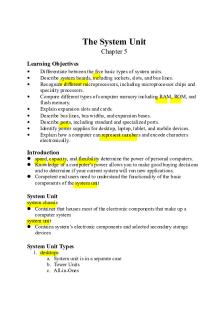Chapter 5 Notes PDF

| Title | Chapter 5 Notes |
|---|---|
| Course | Criminal Procedure |
| Institution | University of Louisville |
| Pages | 3 |
| File Size | 52.4 KB |
| File Type | |
| Total Downloads | 101 |
| Total Views | 141 |
Summary
lecture notes for prof Michael Losavio...
Description
Chapter 5 Notes Searches and Arrests without Warrants Warrantless Searches The four types of warrantless searches are: - Searches incident to an arrest - Searches conducted under exigent circumstances - Searches involving automobiles - Searches based on the "plain view' doctrine Searches Incident to Arrest - When arresting a suspect, police officers must be permitted to search the person and the immediate area in order to protect the officers from harm and to prevent the destruction of evidence. - It would be dangerous to prohibit police from searching arrestees for weapons, and impractical to wait for a warrant before conducting such a search. Restrictions on Searches Incident to Arrest - The arrest itself must be lawful - When the arrest itself is not lawful, that is, when it is not based on probable cause, any search incident to that arrest is unlawful. Timing of the Search Probable cause to arrest must precede the warrantless search. - This is meant to restrict officers from engaging in “fishing expeditions,” or searches based on less than probable cause that would presumably result in probable cause to make an arrest. - A non-contemporaneous search incident to arrest is permissible when: 1. An immediate search is nearly impossible, and 2. The exigency still exists at the time of the later search. Scope of the Search - A search incident to arrest is also limited in scope, or the area that may be searched. - The armspan rule means that a search incident to arrest is limited to the area “within the immediate control” of the person arrested—that is, the area from within which he might have obtained either a weapon or something that could have been used as evidence against him. Expansions of the Armspan Rule - The Court held that at any point up to the time the arrest is completed, the police may engage in a protective sweep, a brief visual inspection of places where someone may be hiding. - Reasonable suspicion must exist for such a sweep to be justified. Thus, no justification is required after arrest, but reasonable suspicion is required to engage in a sweep up to the point of the arrest. Searches Based on Exigent Circumstances Exigent circumstances exception - When the exigencies, or emergency circumstances, of the situation require the police to act immediately to avoid danger to themselves, danger to others, the destruction of evidence, or the escape of the suspect, it would be unreasonable to require the police to take time to obtain a warrant. Three types of exigencies are recognized by the courts as authorizing the police to act without a
warrant: - Hot pursuit - Likelihood of escape or danger to others absent hot pursuit - Evanescent evidence Hot Pursuit Warrantless action based on a hot pursuit exigency is constitutional only if the police have probable cause to believe any of the following: - The person they are pursuing has committed a serious offense. - The person will be found on the premises the police seek to enter. - The suspect will escape or harm someone, or evidence will be lost or destroyed. - The pursuit originates from a lawful vantage point. Evanescent Evidence A warrantless search for evanescent evidence is permissible when: - There is probable cause to believe that evidence will be destroyed, lost, or devalued; - The procedures employed are reasonable; and - The exigency was not police-created Automobile Searches The warrantless search of an automobile is permissible when: - There is probable cause to believe the vehicle contains evidence of a crime, and - Securing a warrant is impractical Five Characteristics of Automobiles - Travel on public roads - Are subject to state regulations and licensing requirements - Are subject to other strict regulations - Are subject to periodic inspections - May be impounded for public safety reasons Requirements for Warrantless Vehicle Searches Three general requirements must be met for a valid warrantless vehicle search: - The exception must only apply to automobiles - With one exception, such a search must be premised on probable cause - It must be impractical to obtain a warrant (i.e., the vehicle stop must be such that it is impractical, burdensome, or risky to take time to obtain a warrant) Plain View Searches A plain view seizure is authorized when: - The police are lawfully in the area where the evidence is located, - The items are immediately apparent as subject to seizure, and - The discovery of the evidence is inadvertent. The Lawful Access Requirement - Plain view alone is never enough to justify the warrantless seizure of evidence. - No amount of probable cause can justify a warrantless search or seizure absent exigent circumstances. - Incontrovertible testimony of the senses that an incriminating object is on premises belonging to a criminal suspect may establish the fullest possible measure of probable cause.
The "Immediately Apparent" Requirement - Immediately apparent means that the officer has probable cause to seize the object - Keep in mind that immediately apparent has virtually the same meaning as probably cause to seize The Role of Inadvertency - An officer who anticipates discovering evidence of a crime should seek prior judicial authorization (a warrant). - If an officer is interested in an item of evidence and fully expects to find it in the course of a search, it should not invalidate its seizure if the search is confined in area and duration by the terms of the warrant or a valid exception to the warrant requirement. Warrantless Arrests Two types of warrantless arrests have been authorized by the Supreme Court: - If exigent circumstances are present, the police may make a warrantless arrest. Probable cause is required, however. - An arrest in public can be made without a warrant. Even certain minor offenses can support arrest in public places....
Similar Free PDFs

Chapter 5 - Lecture notes 5
- 15 Pages

Chapter-5 - Lecture notes 5
- 6 Pages

Chapter 5 - Lecture notes 5
- 83 Pages

Chapter 5 - Lecture notes 5
- 4 Pages

Chapter 5 - Lecture notes 5
- 20 Pages

Chapter 5 - Lecture notes 5
- 4 Pages

Chapter 5 - Lecture notes 5
- 7 Pages

Chapter 5 - Lecture notes 5
- 2 Pages

Chapter 5 - Lecture notes 5
- 3 Pages

Chapter 5 - Lecture notes 5
- 2 Pages

Chapter 5 - Lecture notes 5
- 6 Pages

Chapter 5 - Lecture notes 5
- 6 Pages

Chapter+5 - notes for chapter 5
- 8 Pages

Chapter 5 Notes 4e
- 12 Pages

Chapter 5 Notes
- 15 Pages

Chapter notes 1-5
- 72 Pages
Popular Institutions
- Tinajero National High School - Annex
- Politeknik Caltex Riau
- Yokohama City University
- SGT University
- University of Al-Qadisiyah
- Divine Word College of Vigan
- Techniek College Rotterdam
- Universidade de Santiago
- Universiti Teknologi MARA Cawangan Johor Kampus Pasir Gudang
- Poltekkes Kemenkes Yogyakarta
- Baguio City National High School
- Colegio san marcos
- preparatoria uno
- Centro de Bachillerato Tecnológico Industrial y de Servicios No. 107
- Dalian Maritime University
- Quang Trung Secondary School
- Colegio Tecnológico en Informática
- Corporación Regional de Educación Superior
- Grupo CEDVA
- Dar Al Uloom University
- Centro de Estudios Preuniversitarios de la Universidad Nacional de Ingeniería
- 上智大学
- Aakash International School, Nuna Majara
- San Felipe Neri Catholic School
- Kang Chiao International School - New Taipei City
- Misamis Occidental National High School
- Institución Educativa Escuela Normal Juan Ladrilleros
- Kolehiyo ng Pantukan
- Batanes State College
- Instituto Continental
- Sekolah Menengah Kejuruan Kesehatan Kaltara (Tarakan)
- Colegio de La Inmaculada Concepcion - Cebu